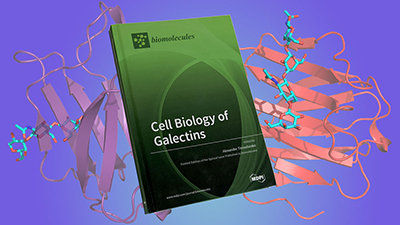News and Events
Contact us
Through the Administrative Office email Directory
or
Departmental Mailing Address:
Department of Biology,
Biological & Geological Sciences Building,
Western University,
London, Ontario, Canada N6A 5B7
Departmental Phone:
519-850-2542
Departmental Fax:
519-661-3935
New book edited by Alexander Timoshenko looks at latest advances of galectins role in cell biology
 When we bite into an apple, we experience the sweet taste coming partly from fructose, a sugar classified as a monosaccharide, the simplest chemical structure required to make more complex molecules called carbohydrates. Other commonly known monosaccharides include glucose and galactose. When two simple sugars are chemically bound together, they form disaccharides such as sucrose (table sugar) composed of glucose and fructose or lactose (milk sugar) composed of glucose and galactose. When you have very long chains or branched structures of monosaccharides linked together you then get polysaccharides or glycans such as what you find in corn starch, wheat flour, cellulose, and on the surface of animal cells.
When we bite into an apple, we experience the sweet taste coming partly from fructose, a sugar classified as a monosaccharide, the simplest chemical structure required to make more complex molecules called carbohydrates. Other commonly known monosaccharides include glucose and galactose. When two simple sugars are chemically bound together, they form disaccharides such as sucrose (table sugar) composed of glucose and fructose or lactose (milk sugar) composed of glucose and galactose. When you have very long chains or branched structures of monosaccharides linked together you then get polysaccharides or glycans such as what you find in corn starch, wheat flour, cellulose, and on the surface of animal cells.
Glycans can take on many metabolic, energy storage, and molecular recognition roles in biological systems and those that contain galactose units bound in a certain way to substrates are galactosides. Galectins act specifically on galactosides and are soluble glycan-binding proteins with diverse expression profiles between tissues and species as well as with different functions outside and inside the cell.
Galectins play a role in many fundamental cellular processes such as cell growth, differentiation, self-renewal, cellular interactions, and other cellular functions. Changes in the expression of galectins are linked to diseases like cancer, heart disease, and fibrosis among others, which suggest they are potential candidates for biomedical applications.
In a new book “Cell Biology of Galectins,” edited by Dr. Alexander Timoshenko, several authors, including Timoshenko, cover the recent progress in the field of cell biology of galectins, relevant concepts of galectin regulatory mechanisms, and biomedical aspects of these unique multifunctional proteins. The novel and challenging aspects of cell biology of galectins addressed in this book might catalyze further experimental investigations into the complex network of these molecules in cells.

